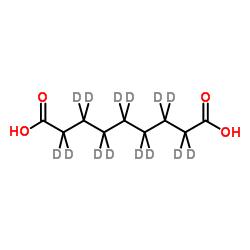(2H14)Nonanedioic acid
Modify Date: 2025-08-25 22:17:30

(2H14)Nonanedioic acid structure
|
Common Name | (2H14)Nonanedioic acid | ||
|---|---|---|---|---|
| CAS Number | 119176-67-9 | Molecular Weight | 202.307 | |
| Density | 1.1±0.1 g/cm3 | Boiling Point | 370.5±25.0 °C at 760 mmHg | |
| Molecular Formula | C9H2D14O4 | Melting Point | N/A | |
| MSDS | N/A | Flash Point | 192.1±19.7 °C | |
Use of (2H14)Nonanedioic acidAzelaic acid-d14 is the deuterium labeled Azelaic acid[1]. Azelaic acid is an organic compound produced by the ozonolysis of oleic acid;component of a number of hair and skin conditioners[2][3]. |
| Name | 1,9-nonanedioic-d14 acid |
|---|---|
| Synonym | More Synonyms |
| Description | Azelaic acid-d14 is the deuterium labeled Azelaic acid[1]. Azelaic acid is an organic compound produced by the ozonolysis of oleic acid;component of a number of hair and skin conditioners[2][3]. |
|---|---|
| Related Catalog | |
| In Vitro | Stable heavy isotopes of hydrogen, carbon, and other elements have been incorporated into drug molecules, largely as tracers for quantitation during the drug development process. Deuteration has gained attention because of its potential to affect the pharmacokinetic and metabolic profiles of drugs[1]. |
| References |
[2]. Jung HW, et al. Priming in systemic plant immunity. Science. 2009 Apr 3;324(5923):89-91. |
| Density | 1.1±0.1 g/cm3 |
|---|---|
| Boiling Point | 370.5±25.0 °C at 760 mmHg |
| Molecular Formula | C9H2D14O4 |
| Molecular Weight | 202.307 |
| Flash Point | 192.1±19.7 °C |
| Exact Mass | 202.192734 |
| PSA | 74.60000 |
| LogP | 1.33 |
| Vapour Pressure | 0.0±1.8 mmHg at 25°C |
| Index of Refraction | 1.475 |
| InChIKey | BDJRBEYXGGNYIS-ODSOAMBASA-N |
| SMILES | O=C(O)CCCCCCCC(=O)O |
| Nonanedioic-D14 Acid |
| (H)Nonanedioic acid |
| Nonanedioic-d acid |